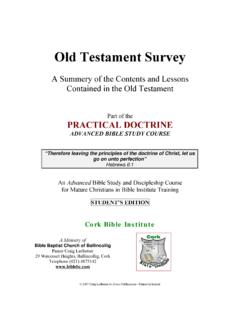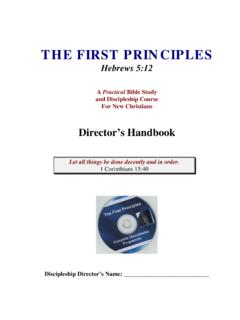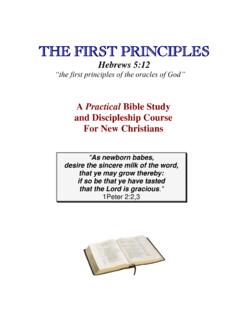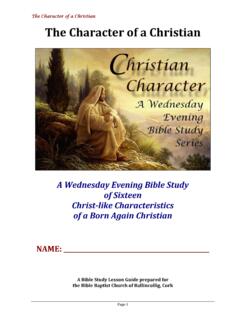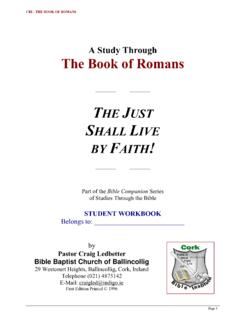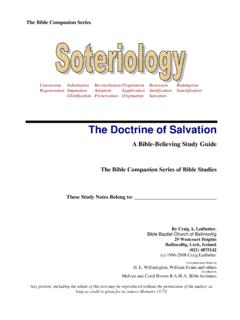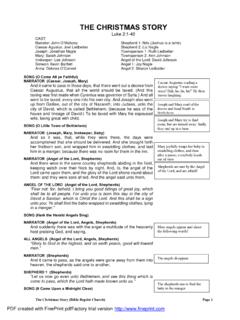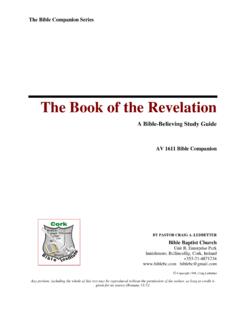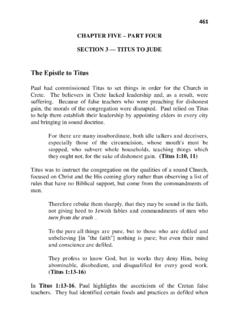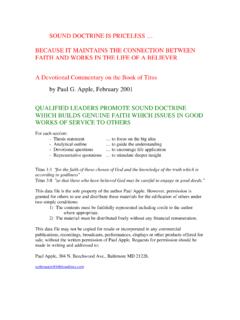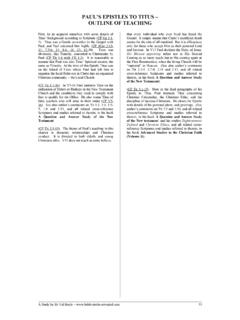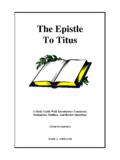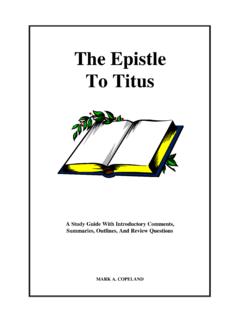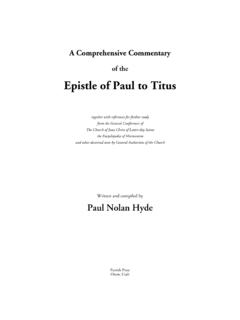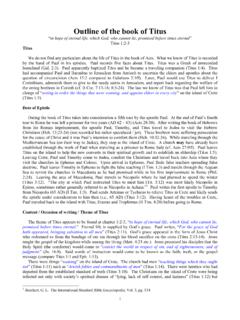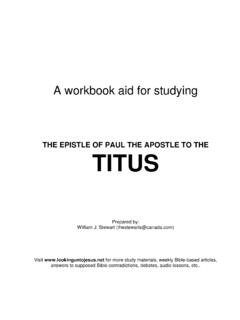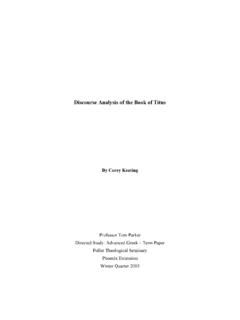Transcription of The Bible Companion Series PASTORAL EPISTLES
1 The Bible Companion Series PASTORAL EPISTLES DEVELOPING SERVANT LEADERSHIP "Let no man despise thy youth; but be thou an example of the believers, in word, in conversation, in charity, in spirit, in faith, in purity." 1 Timothy 4:12 A Study of 1st & 2nd Timothy, titus and Philemon A Bible -Believing Study Guide These Study Notes belong to: _____ AV 1611 Bible Companion BY CRAIG A. LEDBETTER, , Bible Baptist Church 29 Westcourt Heights Ballincollig, Cork, Ireland Tel: (021) 4875142 E-Mail: (c) 2008, Craig Ledbetter Any portion, including the whole of this text may be reproduced without the permission of the author, as long as credit is given for its source (Romans 13:7)!
2 PASTORAL EPISTLES Table of Contents Page 2 Table of Contents TABLE OF FIRST Chapter One You Have a Big Chapter Two The Priority of Chapter Three The Offices of the Chapter Four Protect the Church from False Chapter Five Ministering to Members of the Chapter Six Contentment in the Exam Questions For First Additional Outlines For First THE SECOND epistle TO Chapter 1 Paul the Chapter 2 Paul the Chapter 3 - Paul the Chapter 4 - Paul the Exam Questions for Second Additional Outlines - Second epistle to THE epistle TO Chapter 1 Qualifications for Chapter 2 Foundational Teaching Subjects Part Chapter 3 Foundational Teaching Subjects Part Exam Questions for FINAL EXAM FOR THE PASTORAL Exam Questions For First Exam Questions for Second Exam Questions for A Note Concerning the Cork Bible Institute This study course is intended to be used in conjunction with the Cork Bible Institute and contains Chapter Quizzes and a Final Exam that can be applied towards credit in the Institute.
3 If you want your participation in this course to be part of an overall course accreditation, please inform Pastor Ledbetter and he will make sure your records are retained. Your attendance will be recorded, and there will be a class project for you to complete by the end of the ten week course. Class Projects: To pass this course, you will need to complete the following: 1. Read through 1 & 2 Timothy, Tutus and Philemon twice 2. Read the book, PASTORAL EPISTLES , by Dr. Peter Ruckman 3. Fill-in all the following notes PASTORAL EPISTLES Table of Contents Page 3 4. Attend 80% of the classes 5. Write a 3 page Report on the top five major issues that you believe God wants every church to have right, why they are the most important things to have right, and how a local church should implement God s design in those five areas.
4 6. Memorize the six Scripture verses that are key verses for each chapter. PASTORAL EPISTLES FIRST TIMOTHY Page 4 FIRST TIMOTHY Introduction I. Introduction A. J. Sidlow Baxter says: These PASTORAL EPISTLES - 1 and 2 Timothy and titus , to which is joined the short letter to Philemon - are so named and grouped because they are addressed to Christian pastors. (Even Philemon was a church elder with perhaps considerable PASTORAL engagement; for in addressing him Paul adds, and to the church in thy house. ) B. They have a positional significance which should not be overlooked, fitting, as they do, between the two cohesive main groups of New Testament EPISTLES , the nine Christian Church EPISTLES (Romans to Thessalonians) and the nine Hebrew Christian EPISTLES (Hebrews to Revelation).
5 The two groups differ from each other in viewpoint and emphasis. The PASTORAL EPISTLES , coming between them, fulfil a meaningful function promoting the New testament Church in God s plan. 1. As the Book of the Acts marks the transition from the distinctive message of the Gospels to that of the EPISTLES , so these PASTORAL EPISTLES , both by their nature and their position, mark the transition from the special doctrinal contribution of the Church EPISTLES to the new emphasis and aspects of the Hebrew Christian EPISTLES . 2. There is one part of the Bible more than another which Christian believers should thoroughly study it is that part which is specifically written to Christian believers, namely, the nine Christian Church EPISTLES (Romans to 2 Thessalonians).
6 3. Christian _____ should study the PASTORAL EPISTLES ( 1 and 2 Timothy and titus , to which, quite fittingly as we shall see, is added the letter to Philemon). These PASTORAL EPISTLES are known as such because they have to do with the organized church from the pastor s point of view. They are full of instruction for all Christian believers, of course; yet their message in a special sense concerns those who have the oversight of local Christian assemblies or churches. (Explore the Book; Vol. 6; pp. 230, 231) C. This letter is one of the three New Testament books written especially to pastors of local churches. The other two are 2 Timothy and titus .
7 Philemon is included because he also was a pastor. D. This letter is the first New Testament book to discuss in detail those conditions which should prevail in every local church. E. Statistics: 1. This epistle has six chapters, 113 verses, and 2,269 words. 2. The writer is obviously Paul (see the introduction to this volume for a discussion of these matters), and he is writing to a young man whom he led to the Lord and who was called into the "fulltime ministry," as a pastor, after having ministered to Paul for nearly ten years. 3. Paul composed the letter around _____ between his first and second imprisonment. The following arguments would seem to prove this theory.
8 A. Luke tells us that Paul spent two years in a Roman prison (Acts 28:30). b. During this time he wrote Philippians, Colossians Ephesians, and Philermon. c. In these letters he expresses confidence that a release would be forthcoming (Phil. 1:23-25; 2:24; Philemon 1:22). d. In Romans 15:24 Paul shared his plans to visit Spain. e. But in 2 Timothy 4:7 he stated that he had finished his course. So, at the time of his first imprisonment (Acts 28) he had not visited Spain. Thus he must have been released to make this trip. PASTORAL EPISTLES FIRST TIMOTHY Page 5 F. Paul wrote both 1 Timothy and titus during this earlier imprisonment.
9 1. On July 19, 64, Rome was burned (probably by Nero) and the Christians were blamed. Christianity then became an illegal religion and to evangelise was a crime punishable by death. 2. Paul was probably arrested again sometime after July of 64, and condemned to death. 3. During his second and final imprisonment he wrote 2 Timothy. G. The New Testament has much to say concerning Timothy. 1. His name appears twenty-four times (as Timothy and Timotheus), with his name being mentioned another four times in post scripts after several letters. 2. He was from _____ and probably was saved during Paul s first missionary trip (Acts 14:19, 20; 16:1, 2).
10 3. His mother (_____) and grandmother (____) were godly Jewish women, but his father was a pagan _____ (Acts 16:1; 2 Tim. 1:5). 4. He had been brought up on God s Word (2 Tim. 3:14, 15). 5. He is invited by Paul to join the team during the apostle s second trip (Acts 16:3). This team would consist of Silas, Paul, and Luke. Timothy may have been chosen to take John Mark s place. (See Acts 13:5.) . 6. He is _____ by Paul that he might have freedom to preach the gospel in the various Jewish synagogues (Acts 16:3; see also 1 Cor. 9:20). 7. Timothy is formally ordained by Paul and the presbytery (1 Tim. 4:14; 2 Tim. 1:6). 8. He also accompanies Paul during the third missionary trip (Acts 19:22; 20:4; 2 Cor.)
